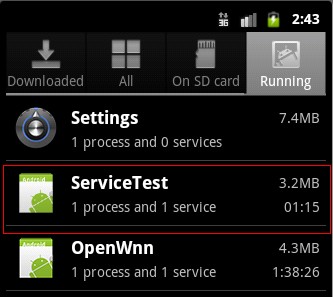一:Service简介
Android开发中,当需要创建在后台运行的程序的时候,就要使用到Service。
1:Service(服务)是一个没有用户界面的在后台运行执行耗时操作的应用组件。其他应用组件能够启动Service,并且当用户切换到另外的应用场景,Service将持续在后台运行。另外,一个组件能够绑定到一个service与之交互(IPC机制),例如,一个service可能会处理网络操作,播放音乐,操作文件I/O或者与内容提供者(content provider)交互,所有这些活动都是在后台进行。
2:Service有两种状态,“启动的”和“绑定:
通过startService()启动的服务处于“启动的”状态,一旦启动,service就在后台运行,即使启动它的应用组件已经被销毁了。通常started状态的service执行单任务并且不返回任何结果给启动者。比如当下载或上传一个文件,当这项操作完成时,service应该停止它本身。
还有一种“绑定”状态的service,通过调用bindService()来启动,一个绑定的service提供一个允许组件与service交互的接口,可以发送请求、获取返回结果,还可以通过夸进程通信来交互(IPC)。绑定的service只有当应用组件绑定后才能运行,多个组件可以绑定一个service,当调用unbind()方法时,这个service就会被销毁了。
3:service与activity一样都存在与当前进程的主线程中,所以,一些阻塞UI的操作,比如耗时操作不能放在service里进行,比如另外开启一个线程来处理诸如网络请求的耗时操作。如果在service里进行一些耗CPU和耗时操作,可能会引发ANR警告,这时应用会弹出是强制关闭还是等待的对话框。所以,对service的理解就是和activity平级的,只不过是看不见的,在后台运行的一个组件,这也是为什么和activity同被说为Android的基本组件。
二:Service的生命周期
Android Service生命周期与Activity生命周期是相似的,但是也存在一些细节上也存在着重要的不同:
onCreate和onStart是不同的
通过从客户端调用Context.startService(Intent)方法我们可以启动一个服务。如果这个服务还没有运行,Android将启动它并且在onCreate方法之后调用它的onStart方法。如果这个服务已经在运行,那么它的onStart方法将被新的Intent再次调用。所以对于单个运行的Service它的onStart方法被反复调用是完全可能的并且是很正常的。
onResume、onPause以及onStop是不需要的
回调一个服务通常是没有用户界面的,所以我们也就不需要onPause、onResume或者onStop方法了。无论何时一个运行中的Service它总是在后台运行。
onBind
如果一个客户端需要持久的连接到一个服务,那么他可以调用Context.bindService方法。如果这个服务没有运行方法将通过调用onCreate方法去创建这个服务但并不调用onStart方法来启动它。相反,onBind方法将被客户端的Intent调用,并且它返回一个IBind对象以便客户端稍后可以调用这个服务。同一服务被客户端同时启动和绑定是很正常的。
onDestroy
与Activity一样,当一个服务被结束是onDestroy方法将会被调用。当没有客户端启动或绑定到一个服务时Android将终结这个服务。与很多Activity时的情况一样,当内存很低的时候Android也可能会终结一个服务。如果这种情况发生,Android也可能在内存够用的时候尝试启动被终止的服务,所以你的服务必须为重启持久保存信息,并且最好在onStart方法内来做。
三.Service的启动方式
Service的启动方式有如下2种
CstartService()和bindService(),这两种方式对Service生命周期的影响是不同的。

startservice是由其他组件调用startService()方法启动的,这导致服务的onStartCommand()方法被调用,当服务是started状态时,其生命周期与启动它的组件无关,并且可以在后台无限期运行,即使启动服务的组件已经被销毁。因此,服务需要在完成任务后调用stopself()方法停止,或者有其他组件调用stopService()方法停止。
使用bindService()方法启用服务,调用者与服务绑定在了一起,调用者一旦退出,服务也就终止,大有‘不求同生,但求同死’的特点
Android应用中每个Service都必须要在AndroidMainifest.Xml配置文件中声明。
四:2种启动方式的具体例子
启动时,startService –> onCreate() –> onStart()
停止时,stopService –> onDestroy()
startService()方式启动 Service的方法:
<?xml version="1.0" encoding="utf-8"?> <LinearLayout xmlns:android="http://schemas.android.com/apk/res/android" android:orientation="vertical" android:layout_width="fill_parent" android:layout_height="fill_parent" > <Button android:id="@+id/startBtn" android:layout_width="match_parent" android:layout_height="wrap_content" android:text="启动 Service" /> <Button android:id="@+id/stopBtn" android:layout_width="match_parent" android:layout_height="wrap_content" android:text="停止 Service" /> </LinearLayout>
MainActivity.java
package com.android.service.activity; import android.app.Activity; import android.content.Intent; import android.os.Bundle; import android.view.View; import android.view.View.OnClickListener; import android.widget.Button; public class MainActivity extends Activity { private Button startBtn; private Button stopBtn; @Override public void onCreate(Bundle savedInstanceState) { super.onCreate(savedInstanceState); setContentView(R.layout.main); startBtn = (Button) findViewById(R.id.startBtn); stopBtn = (Button) findViewById(R.id.stopBtn); //添加监听器 startBtn.setOnClickListener(listener); stopBtn.setOnClickListener(listener); } //启动监听器 private OnClickListener listener=new OnClickListener() { @Override public void onClick(View v) { Intent intent=new Intent(MainActivity.this, ServiceDemo.class); switch (v.getId()) { case R.id.startBtn: startService(intent); break; case R.id.stopBtn: stopService(intent); break; default: break; } } }; }
新建ServiceDemo类,ServiceDemo.java如下
package com.android.service.activity; import android.app.Service; import android.content.Intent; import android.os.IBinder; import android.util.Log; public class ServiceDemo extends Service { private static final String TAG="Test"; @Override //Service时被调用 public void onCreate() { Log.i(TAG, "Service onCreate--->"); super.onCreate(); } @Override //当调用者使用startService()方法启动Service时,该方法被调用 public void onStart(Intent intent, int startId) { Log.i(TAG, "Service onStart--->"); super.onStart(intent, startId); } @Override //当Service不在使用时调用 public void onDestroy() { Log.i(TAG, "Service onDestroy--->"); super.onDestroy(); } @Override //当使用startService()方法启动Service时,方法体内只需写return null public IBinder onBind(Intent intent) { return null; } }
在AndroidManifest.xml文件中添加16~21行的声明
<?xml version="1.0" encoding="utf-8"?> <manifest xmlns:android="http://schemas.android.com/apk/res/android" package="com.android.service.activity" android:versionCode="1" android:versionName="1.0"> <uses-sdk android:minSdkVersion="10" /> <application android:icon="@drawable/icon" android:label="@string/app_name"> <activity android:name=".MainActivity" android:label="@string/app_name"> <intent-filter> <action android:name="android.intent.action.MAIN" /> <category android:name="android.intent.category.LAUNCHER" /> </intent-filter> </activity> <service android:name=".ServiceDemo" > <intent-filter> <action android:name="android.intent.action.MAIN" /> <category android:name="android.intent.category.LAUNCHER" /> </intent-filter> </service> </application> </manifest>
效果如下:

当点击![]() 按钮时,先后执行了Service中onCreate()->onStart()这两个方法,LogCat显示如下:
按钮时,先后执行了Service中onCreate()->onStart()这两个方法,LogCat显示如下:

当点击 ![]() 按钮时,Service则执行了onDestroy()方法,LogCat显示如下:
按钮时,Service则执行了onDestroy()方法,LogCat显示如下:

退出后,进入Settings(设置)->Applications(应用)->Running Services(正在运行的服务)看一下我们新启动了的服务,效果图如下:
绑定时,bindService -> onCreate() –> onBind()
<?xml version="1.0" encoding="utf-8"?> <LinearLayout xmlns:android="http://schemas.android.com/apk/res/android" android:orientation="vertical" android:layout_width="fill_parent" android:layout_height="fill_parent" > <Button android:text="启动Service" android:id="@+id/startBtn1" android:layout_width="match_parent" android:layout_height="wrap_content" /> <Button android:text="停止Service" android:id="@+id/stopBtn2" android:layout_width="match_parent" android:layout_height="wrap_content" /> <Button android:text="绑定Service" android:id="@+id/bindBtn3" android:layout_width="match_parent" android:layout_height="wrap_content" /> <Button android:text="解除绑定" android:id="@+id/unbindBtn4" android:layout_width="match_parent" android:layout_height="wrap_content" /> </LinearLayout>
MainActivity.java
package com.android.bindservice.activity; import android.app.Activity; import android.app.Service; import android.content.ComponentName; import android.content.Intent; import android.content.ServiceConnection; import android.os.Bundle; import android.os.IBinder; import android.util.Log; import android.view.View; import android.view.View.OnClickListener; import android.widget.Button; public class MainActivity extends Activity { // 声明Button private Button startBtn,stopBtn,bindBtn,unbindBtn; @Override public void onCreate(Bundle savedInstanceState) { super.onCreate(savedInstanceState); // 设置当前布局视图 setContentView(R.layout.main); // 实例化Button startBtn = (Button)findViewById(R.id.startBtn1); stopBtn = (Button)findViewById(R.id.stopBtn2); bindBtn = (Button)findViewById(R.id.bindBtn3); unbindBtn = (Button)findViewById(R.id.unbindBtn4); // 添加监听器 startBtn.setOnClickListener(startListener); stopBtn.setOnClickListener(stopListener); bindBtn.setOnClickListener(bindListener); unbindBtn.setOnClickListener(unBindListener); } // 启动Service监听器 private OnClickListener startListener = new OnClickListener() { @Override public void onClick(View v) { // 创建Intent Intent intent = new Intent(); // 设置Class属性 intent.setClass(MainActivity.this, BindService.class); // 启动该Service startService(intent); } }; // 停止Service监听器 private OnClickListener stopListener = new OnClickListener() { @Override public void onClick(View v) { // 创建Intent Intent intent = new Intent(); // 设置Class属性 intent.setClass(MainActivity.this, BindService.class); // 启动该Service stopService(intent); } }; // 连接对象 private ServiceConnection conn = new ServiceConnection() { @Override public void onServiceConnected(ComponentName name, IBinder service) { Log.i("Service", "连接成功!"); } @Override public void onServiceDisconnected(ComponentName name) { Log.i("Service", "断开连接!"); } }; // 綁定Service监听器 private OnClickListener bindListener = new OnClickListener() { @Override public void onClick(View v) { // 创建Intent Intent intent = new Intent(); // 设置Class属性 intent.setClass(MainActivity.this, BindService.class); // 绑定Service bindService(intent, conn, Service.BIND_AUTO_CREATE); } }; // 解除绑定Service监听器 private OnClickListener unBindListener = new OnClickListener() { @Override public void onClick(View v) { // 创建Intent Intent intent = new Intent(); // 设置Class属性 intent.setClass(MainActivity.this, BindService.class); // 解除绑定Service unbindService(conn); } }; }
BindService.java
package com.android.bindservice.activity; import android.app.Service; import android.content.Intent; import android.os.IBinder; import android.util.Log; public class BindService extends Service{ private static final String TAG="Test"; //返回null public IBinder onBind(Intent intent) { Log.i(TAG, "Service onBind--->"); return null; } // Service创建时调用 public void onCreate() { Log.i(TAG, "Service onCreate--->"); } // 当客户端调用startService()方法启动Service时,该方法被调用 public void onStart(Intent intent, int startId) { Log.i(TAG, "Service onStart--->"); } // 当Service不再使用时调用 public void onDestroy() { Log.i(TAG, "Service onDestroy--->"); } // 当解除绑定时调用 public boolean onUnbind(Intent intent) { Log.i(TAG, "Service onUnbind--->"); return super.onUnbind(intent); } }
在AndroidManifest.xml文件中添加16~21行的声明
<?xml version="1.0" encoding="utf-8"?> <manifest xmlns:android="http://schemas.android.com/apk/res/android" package="com.android.bindservice.activity" android:versionCode="1" android:versionName="1.0"> <uses-sdk android:minSdkVersion="10" /> <application android:icon="@drawable/icon" android:label="@string/app_name"> <activity android:name=".MainActivity" android:label="@string/app_name"> <intent-filter> <action android:name="android.intent.action.MAIN" /> <category android:name="android.intent.category.LAUNCHER" /> </intent-filter> </activity> <service android:name=".BindService" > <intent-filter> <action android:name="android.intent.action.MAIN" /> <category android:name="android.intent.category.LAUNCHER" /> </intent-filter> </service> </application> </manifest>
效果如下:

当点击![]() 按钮时,先后执行了Service中onCreate()->onStart()这两个方法,LogCat显示如下:
按钮时,先后执行了Service中onCreate()->onStart()这两个方法,LogCat显示如下:

当点击![]() 按钮,则Service执行了onUnbind()方法,LogCat显示如下:
按钮,则Service执行了onUnbind()方法,LogCat显示如下:


